Final report for FNC21-1295
Project Information
I have been growing native corn in my backyard plot (40 x 25 ft) for four years, using organic and sustainable practices like companion planting (three sisters and others), composting and crop rotation. Taking into consideration the great results from 2021, in 2022 I decided to expand my farming space, designating a 30 x 24 ft plot for Bofo corn, and a 20 x 24 ft plot for Avati Moroti Mita corn. In 2022, Bofo was planted in a "milpa" system with turkey craw beans, sunflowers, blue hubbard squash, chiles and tomatillos. Bofo seed was planted 1 foot apart. In 2022, the Avati Moroti Mita plot was planted with seeds one foot apart, and sunflowers as a companion. Two feet between the rows were respected for both varieties. Three other farmers that participate in this project also grew heritage corn since about six years ago in their farms/homesteads, using agro-ecologic practices as well. Jon Zirkle operates a six-acre educational farm with a 20 x 100 ft plot devoted to native corn and other areas devoted to CSA agriculture and land restoration. The heritage corn plot at Bushelcraft Farm (Jon Zirkle) was reduced in size in 2022 to account for reasonable management. Ten rows of corn were planted, approximately 24 inches between rows and 6-8 inch spacing within the row. Rows were 100 feet long and were planted June 24-25 and June 28. Due to heavy rains in July soon thereafter, many seeds were replanted to fill in gaps within rows. John Sherck operates a 2-acre farm/homestead with a 20 x 60 ft plot for heritage corn and other plots for diverse produce. Steven Shantz has a homestead/farm with two 20 x 25 ft plots devoted to native corn. With this group of farmers, we created an informal Heritage Corn Project. From working together and talking through our experiences and concerns, came the ideas for researching heritage corn at the backyard level, through a SARE grant project.
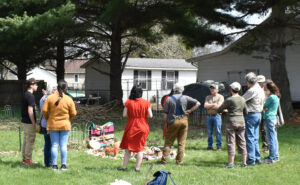
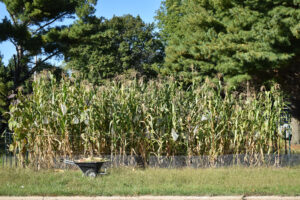
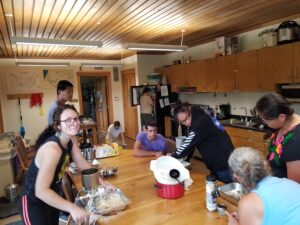
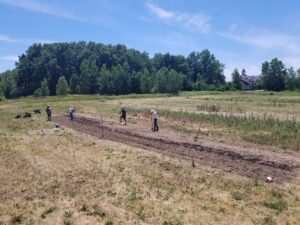

Many folks want to grow small-scale heritage corn at home, though knowledge of how to do so successfully is lacking, as is cultural awareness about corn diversity. With much of northern Indiana in close proximity to commercial cornfields with GMO traits, growing small-scale GMO-free heritage corn for human consumption and seed saving is challenging. Corn pollen, although heavy, can travel up more than 1640 feet, and can be found more than a half a mile away from its source plant (Agriculture and Natural Resources, March 15, 2016). This distance can certainly vary depending on wind, humidity and temperature. Since commercial corn pollen travels far, is backyard heritage corn GMO contaminated? Should we test? In 2021 and 2022, five+ farmers grew plots of heritage corn (varieties seed saved from 2019, 2020) for processing, eating, seed saving, and sharing, with attempts to reduce GMO contamination by planting date (late planting) and with hand pollination techniques to improve purity. Considering commercial corn's pollination window in Indiana is between late June to mid-July, the group selected either very early maturing heritage corn; late planting (late June) of regular season varieties; and early planting of very late maturing heritage corn. Corn from three of the farms underwent GMO testing in 2021 and 2022. A database was created to keep track of varieties; planting, tassel, and harvest dates; as well as challenges and observations.
Qualitative GMO testing of three varieties in 2021 resulted in "not detected". In 2022, the same approach to avoid GMO contamination was pursued (planting date, hand pollinating), and the result for Qualitative GMO testing for two varieties was 0.06% for open pollinated Avati Moroti Mita; and <0.05% for Open pollinated Bofo. Both results were well below de 0.9% standard for the Non-GMO Project. The hand pollinated Avati corn, our control piece in the research, received a "not detected" qualitative result for the second year in a row.
Throughout the 2021 and 2022 seasons, growers gathered as families and shared the cultural value, preparation, planting techniques, pest control, challenges of cultivating backyard heritage corn, and its uses for food sustenance, by organizing and teaching 20 ceremonies/trainings/field sessions/workshops and three larger community events. The group was diverse in age, including children ages 7-11; youth interns 16-18; as well as college students; and adults up to 78 years old. Digital resources (presentations and social media posts) document learning and are shared publicly to enhance community learning. Corn seed was shared with new seed stewards, and a community network of heritage corn stewards and enthusiasts was supported.
Growers now feel confident that taking into consideration the planting date and time to tassel of heritage corn to avoid the pollination window with commercial GMO corn, is effective in keeping sacred heritage corn seed free from GMOs, within the backyard plots. Growers now have more context of the cultural value of corn as a staple crop. They have been reassured in their agroecological practices, have learned new ways to embrace climate change and pest damage, and consequently improved their yield and product quality.
-
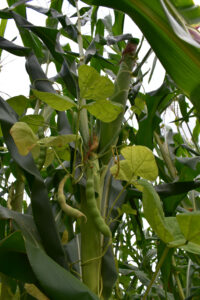
Bofo heritage corn grown in milpa system in a research plot. 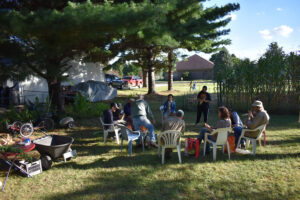
Group husking and collaborative learning about true to type qualities. Photo by Gerardo Morales
Grow backyard heritage corn in Northern Indiana with sustainable practices, collecting data from experiments with planting dates and hand pollination to avoid GMO contamination from commercial corn. - Identify the resources needed for raising heritage corn at the backyard scale, for the sustenance of households, seed saving and sharing.
- Educate our community of the biological, cultural, agronomic, economic, and health implications of heritage corn production at the homestead level through family-to-family, farmer-to-farmer, and farmer-to-community educational trainings and events, social media and video documentaries.
- https://youtu.be/Zdkv4j4twGs
Cooperators
- - Producer
- - Producer
Research
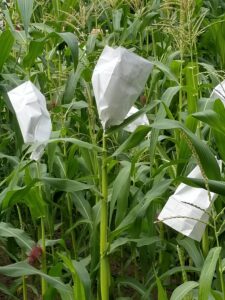
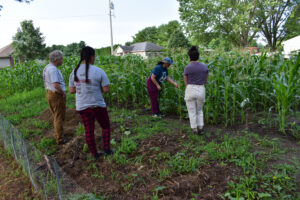
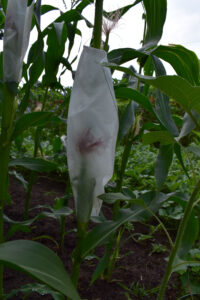
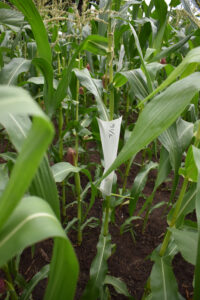
Methodology
In 2021, test plots at three farms were identified for research data collection. At two farms (Prieto in Goshen, IN and Bushelcraft Farm in Elkhart, IN), a selection of ears were hand pollinated and bagged to generate ears that were known to have pollen only from the corn plants in the patch. This was done using methods from Suzanne Ashworth's book, Seed to Seed (1991). At Bushelcraft Farm, about 47 ears were hand pollinated on Aug 21 and about 57 were hand pollinated on Sept 19. The patch of Walpole Island White Flour corn emerged and grew quite unevenly, and it was not possible to generate 100 ears at the same time. At harvest, ears that were open pollinated were separated from hand pollinated ears. Ears were dried slowly in an enclosed space to minimal moisture levels. Not all hand pollinated ears actually formed, but the seed of the ears that did form was mixed together and between 600-700 seeds were extracted for a sample to be submitted for GMO contamination testing, and 600+ seeds of open pollinated seed after randomly selecting ears that looked otherwise good for seed saving and for eating the grain. At Zuleyja Prieto's corn patch, 50 ears of Avati Moroti were selected, hand pollinated, and bagged on July 21 and July 22. 600+seeds of hand pollinated seed and 600+ seeds of open pollinated seed were selected, then bagged and labeled separately for lab testing. Farmer Steve Shantz (Goshen, IN) was not able to hand pollinate his 'Darwin John' corn, but collected at least 600+seeds from open pollinated ears. These five samples were submitted for GMO testing to Food Chain ID Testing Services (Chantilly, VA) in December 2021.
In 2022, two plots were selected as research plots. At Zuleyja Prieto’s plot (20 x 24 ft), 50 ears of Avati Moroti Mita were selected, hand pollinated, and bagged on July 15 and 16, 2022. 1,500 seeds of hand pollinated seed and 3,000 seeds of open pollinated seed were selected, then bagged and labeled separately for lab testing. Bofo corn, a late maturing, open pollinated variety, was also tested for GMO traits. 3,000 seeds were sent for qualitative testing. The same lab was used to test for GMO traits on both years. At Bushelcraft Farm, about 1800 seeds of Benugzegnug (‘Walpole Island White Flour Corn’) were planted (20’ x 100’). The goal was to have 50 ears that were hand pollinated and 50 ears that were not to send in for testing. Only about 30 ears were hand pollinated, and success rate was not good and stormy weather caused many bags to come off. Unfortunately, fencing around the plot fell down as ears matured and Jon Zirkle prepared for a major surgery. Deer and raccoon consumed 100% of the crop.
Proposed Methods
Test plots of heritage corn will consist of ten rows that are 25’ long with 30” between rows (20’ x 25’). Corn is planted every six inches within the row. In some cases, farmers may plant multiple plots of this exact size but at staggered planting dates. Each of the four sites will be planted to heritage varieties selected by the group in spring 2021. Planting dates selected will allow corn varieties to reach maturity but not cross with pollination window of commercial corn. We suspect planting many varieties in mid to late June will help corn avoid pollinating when most commercial corn is pollinating (typically in July) but be early enough to still mature before frost. Before tasseling, half of each plot (5 contiguous rows) will be divided at three farms. One half will be hand pollinated and tassel + shoot bags used on baby ears, the other half left alone.
At harvest, randomizing tools will help us select five 10’ stretches of corn from each farm’s corn plot. (At farms listed above, this process will happen on both the hand-pollinated half and control half of plot). Group husking will allow the team to assess visual quality of harvest ears, guiding seed saving. To take grain samples, all ears from the five 10’ rows per plot will be laid out and ears randomly selected for counting and averaging number of kernels, counting and measuring mature ear length. 3000 dried seeds will be collected from a mix of 20 random ears, then sent to ICIA for GMO testing in fall of 2021 and 2022. Seed will be properly dried and stored in a community freezer after labeling.
The teaching methods used for educational purposes will include hand-on trainings, presentations at larger events, and social media posts with ongoing discussion.
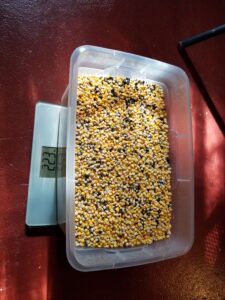
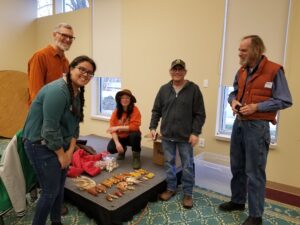
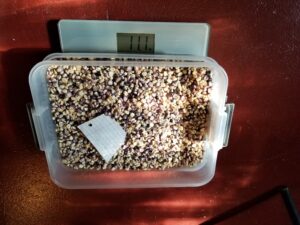
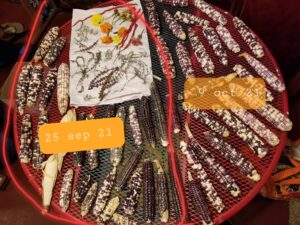

In January 2022, qualitative lab results from Food Chain ID Testing Services showed that all corn seed submitted showed no GMO contamination above the 0.5% threshold. This is well below the Non GMO Project's threshold of 0.9%.
Bushelcraft Farm also submitted a separate sample of 600+ dried seeds from open-pollinated Walpole Island White Flour Corn to Food Chain ID Testing Services for mycotoxin testing. Of the 14 mycotoxins tested for, none were detected at the level of detection (LOD).
In January 2023, quantitative lab results from Food Chain ID Testing Services showed <0.05% GMO contamination for CaMV 35S Promoter; GA21; MIR604; and MIR162, respectively for Bofo, open pollinated corn. The PCR analysis for the open pollinated Avati Moroti Mita corn was as follows: CaMV 35S Promoter, 0.06%; GA21 <0.05%; MIR604 <0.05%; MIR162 <0.05%, for a total of 0.06% GMO. The hand-pollinated Avati Moroti Mita submitted for qualitative testing, resulting in "not detected", the same as in 2022. Due to our limited sample size, the lab calculated a limit of GMO detection of 0.5%. For the second year in a row, our results were well below our specific threshold and the Non-GMO project standard of 0.9%.
Also in 2023, mycotoxin testing (14 mycotoxins) for open-pollinated Bofo and Avati corns was requested. Bofo was clean; and for Avati, 1,5-Acetyldeoxynivalenol that was just below the LOQ, and it was reported as < 0.10. the actual result was 0.09 ppm.
Educational & Outreach Activities
Educational table, presentation, display and ceremony at Goshen's 1st Indigenous People's Day Celebration. 10/11/22, 210 attendees
Attended as a group to a Harvest Ceremony led by Wixaritari elders from Mexico, where an ancient Mother Corn and its harvest was blessed in its first year growing in the area. Kalamazoo College, 180 attendees.
Educational table, display and corn tasting at the 2023 Michiana Regional Seed Swap. 1/21/23, 350+ attendees
Participation Summary:
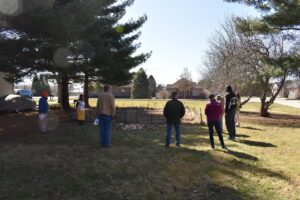
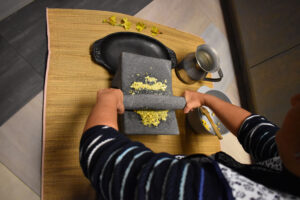
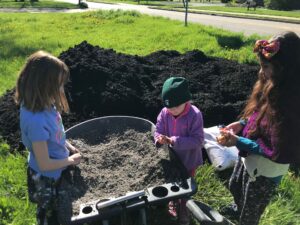
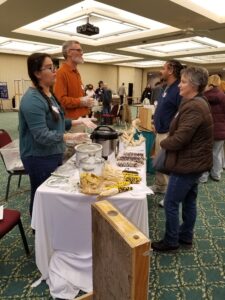
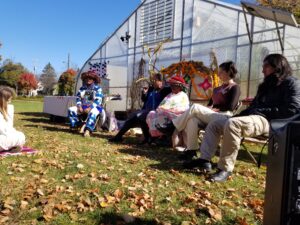
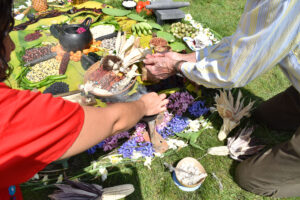
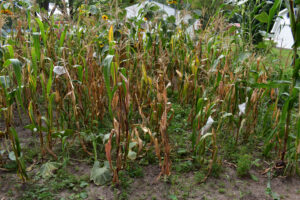
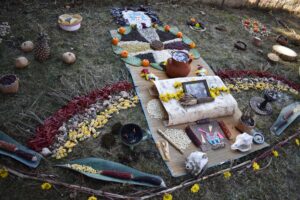
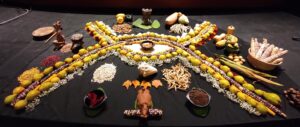
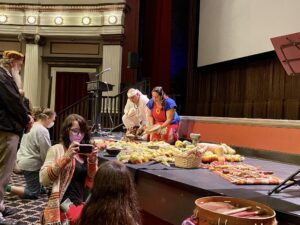
2021
1. Three Trainings via Zoom: What Heritage Corn Needs to Thrive (six live participants); Preparing the Land (four live participants); Soil testing and Amending the Soil (six live participants). All trainings were recorded and viewed by approximately 200 people on social media.
2. Four field sessions/workshops: Seed blessing ceremony (12 participants); Preparing the Land (4 participants); Seed Planting Ceremony and Planting at one Farm (16 participants); Hand Pollinating Technique (4 participants); Harvesting and Group Husking (16 participants).
3. On farm demonstration and tour was attended by 15 people
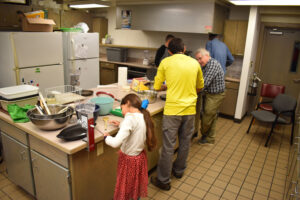
4. Large educational event was attended by +300 people, around 60 people stopped at the booth and 20 participated in cultural/educational activities provided by us (corn husk doll making while listening to Native American tales; estimating amount of seeds in a jar for a prize)
We manage the Facebook page: Rooting Through Corn, Planting Families, where we try to communicate, in a bilingual format, what we have learned, as well as share relevant information with our followers. Refer to this page for pictures, posts and updates on the project.
In 20221, we got media coverage from El Puente News (www.webelpuente.com) as well as a brief highlight of the project in the magazine Edible Michiana.
2022
- Two trainings via Zoom, live on Facebook. Planning Your Garden: location, arrangement, wind proofing, fencing (8 live participants); and Plant Cycle, Record Keeping, Weeding and Cover Crops (12 live participants). All trainings were recorded and viewed by approximately 200 people on social media.
- Seven field sessions/workshops: Group Grinding (25 participants); Blessing of the seed Ceremony (17 participants); Preparing the Land (14 participants); Seed Planting Ceremony and Planting at one Farm (7 participants); Hand Pollinating Technique (7 participants); Tortilla Making (21 participants); End oy Year Gathering, planning for Seed Swap event, informal reporting (9 participants).
- On farm demonstration of hand pollinating technique and harvest selection (10 participants)
- Large educational event: Indigenous People's Day in Goshen, 210 attendees. Presentation, corn display, and ceremony.
- Large educational event: Harvest Celebration at Kalamazoo College (7 participants attended). Harvest Ceremony led by Wixaritari elders from Mexico, where an ancient Mother Corn and its harvest was blessed in its first year growing in the area. 180 attendees.
- Large educational event: 2023 Michiana Regional Seed Swap (January 21, 20223), corn display and food tasting of different varieties of corn cultivated, 350+ attendees.
We participated as speakers at the Michiana Regional Seed Swap on February 16, 2022, (125 attendees) and participated in the Zero Waste Challenge Webinar series offered by the City of Goshen on February 24, 2022. (12 online attendees). Preliminary project results were also presented at Kalamazoo College's Harvest Celebration on October 28, 2022, in Kalamazoo, Michigan (60 attendees). Seven project members, including two children and two students, are signed up to attend the Michigan Family Farm Conference on February 25, 2023.
Get To Know Your Soil_ Texture and Fertilizers BFC 4.28.21
Growing Food at Home But Not Alone - Prieto and Zirkle 2.24.22
Indigenous Principles in the Garden - Zuleyja Prieto
Rooting Through Corn Planting Families 2.19.22
RTCPF at Kalamazoo College - Zuleyja Prieto
Soil Fertility, Soil Testing, and Raising Heritage Corn 4.16.2021 (2)

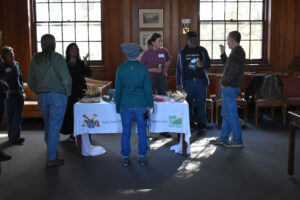
Learning Outcomes
I learned to plan for and better visualize my planting strategies. I also learned a lot through coordinating trainings/events, communications and fellow grant participants. This affected my farm operation in a positive manner, as I was prepared for all the phases even before putting any seeds in the ground. The more knowledge, support, and practice encouraged me to expand my planting field in 2022. As a result of this we got a better yield, anticipated pests, incorporated timely cover cropping, wind proofed and critter proofed better, among others. Off the field I learned more about seed saving, processing, cooking, and eating heritage corn. Facing challenges like time-consuming hand pollination and terrible windstorms that threatened the farm were learning experiences to better plan for future seasons.
One of the best advantages of a project such as ours is the collective learning experience. As a collective we were able to learn from senior farmers as well as newcomers. We were able to maintain our seeds GMO free, which is an advantage to our seed bank, families, and community. More families are now stewards of heritage corn, and know how to cultivate it, keep it clean from GMO, and use it for their sustenance.
One of the disadvantages of implementing a project with corn, is that corn requires larger amounts of land in order to avoid inbreeding, and that is not available to some of the community members who participated in this project. However, the same model may be used for community gardens and shared plots.
I would advise other farmers who want to cultivate non-GMO heritage corn in Northern Indiana to first research the distance between their plots and surrounding commercial plots, get an approximate planting/tassel/harvest date for this commercial (and most likely GMO) corn. Secondly, I would recommend corn growers to know the corn variety they wish to plant. Know what a "true-to-type" specimen of that variety looks like, as well as days to tassel and days to maturity. Third, I would suggest that farmers take into consideration natural/aquired barriers that may impede pollen from commercial plots to reach their farm or backyard plot, such as tree lines, bushes, fences, housing, larger buildings, etc.
With all this in mind, plan on late planting, as to avoid tassel (pollination) times to combine with commercial corn. Finally, at the end of the season, I would recommend at least qualitative PCR testing for GMO contaminants in a randomized selection of seeds, to confirm that the variety is indeed free of GMOs. However, we must take into consideration that GMO testing is costly and, in our case, would not have been possible/practical without grant support.
Growing corn in urban or suburban environments farther from commercial corn has potential for success for growing non-GMO heritage corn safely. While we can’t prove that being in urban and suburban environments to grow backyard corn is enough to prevent GMO pollen, such environments coupled with late planting are probably effective methods. This could be trialed for further testing.
In open rural environments that have few or no physical barriers to cross-contamination with GMO corn, it appears that planting heritage corn late may be effective. Planting the last week of June in 2021, heritage corn samples from 2021 (at Bushelcraft Farm, Elkhart, IN) were found to be well below the acceptable GMO contamination threshold used by the Non-GMO Project.
Since in our findings we did not encounter a difference in GMO contamination between hand pollinated and open pollinated samples, I do not recommend hand pollination as an option to keep native corn free of GMOs, as it is time consuming, more materials are required/more waste produced; and it is not a viable option for large plots. We learned hand pollinating techniques for corn with this project, and we appreciate that learning process very much.
When working with family plots, encourage participation of all ages, work on creating a support network and share resources. Record keeping is critical to better understand the challenges that come up and find ways to embrace them. Finally, I would encourage farmers to really hold space for cultural and ceremonial practices, that add value and intention to our farming practices.
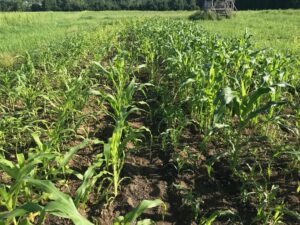
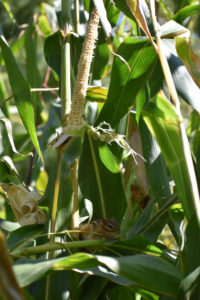
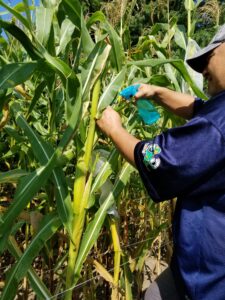
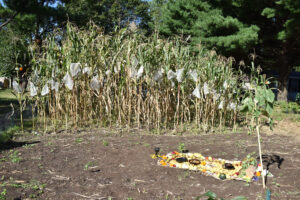
Project Outcomes
(First time backyard corn grower in Elkhart, Indiana) "I learned more in this training session with you guys, than years and years of reading and trials."
The first year I grew Bofo corn, a native variety from Mexico, in my backyard I got 8 ears from a 20 x 20 foot plot. The second year I got 16 ears and cornworm damage was extense. On this third year, by amending my soil, early planting (as this is a very late maturing variety), applying biological pesticides, and increasing my plot size (20 x 25), I got 11 pounds of seed for eating and plenty of seeds for saving and sharing.
"Knowing that the native seed we began with and the seed we produced is free of GMOs is wonderful. All this hard work has its rewards!" - experienced farmer in Bristol, Indiana
"I come to these workshops to learn from everybody, then I go back to my plot and use it." - Backyard heritage corn grower in Fort Wayne, Indiana
"You really hit a home run with the Hand Pollinating Technique Workshop. The process is amazing and having the hands-on experience and the results was amazing." - Farmer in Goshen, Indiana
I appreciate the constant support we have received from SARE in this learning process.